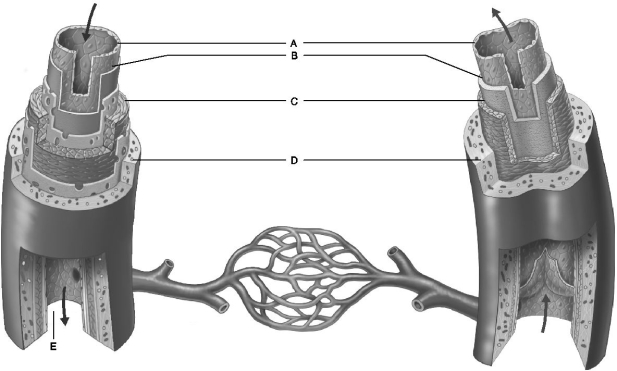Correct Answer

verified
Correct Answer
verified
Multiple Choice
Phlebitis is
A) ballooning of an artery.
B) cancer of the tunica intima.
C) a condition characterized by excessively leaky capillaries.
D) inflammation of a vein.
Correct Answer

verified
Correct Answer
verified
Multiple Choice
Blood passing through the fetal ductus arteriosus bypasses the
A) right ventricle, pulmonary trunk, and lungs.
B) right atrium and ventricle.
C) pulmonary trunk and lungs.
D) lungs, left atrium, and ventricle.
Correct Answer

verified
Correct Answer
verified
Multiple Choice
In a capillary bed, relaxation of the precapillary sphincters causes more blood to flow
A) through the metarterioles.
B) through the true capillaries.
C) into the arterioles.
D) into the thoroughfare channels.
Correct Answer

verified
Correct Answer
verified
Multiple Choice
 Figure 20.1
Use the diagram above to answer the following questions.
-Identify the letter that is indicating the lumen.
Figure 20.1
Use the diagram above to answer the following questions.
-Identify the letter that is indicating the lumen.
A) A
B) B
C) C
D) D
E) E
Correct Answer

verified
Correct Answer
verified
Multiple Choice
Wide leaky capillaries found in bone marrow and spleen.
A) continuous capillaries
B) metarterioles
C) sinusoids
D) fenestrated capillaries
E) none of the above
Correct Answer

verified
Correct Answer
verified
Multiple Choice
The abdominal aorta divides at its distal end into which arteries?
A) the femoral arteries
B) the common iliac arteries
C) the external iliac arteries
D) the internal iliac arteries
Correct Answer

verified
Correct Answer
verified
Multiple Choice
A blood vessel that ranges from 0.3 mm to about 1 cm in diameter and has a large tunica media relative to the size of the lumen is
A) a muscular artery.
B) a capillary.
C) an elastic artery.
D) an arteriole.
Correct Answer

verified
Correct Answer
verified
True/False
Postcapillary venules function much like true capillaries.
Correct Answer

verified
Correct Answer
verified
Multiple Choice
Which of the following statements about arterioles is false?
A) They have the largest content of smooth muscle in their tunica media.
B) They regulate the flow of blood to capillary beds through contraction and relaxation of the tunica media.
C) They redirect blood flow in a sympathetic response to skeletal muscle.
D) They can lead into metarterioles.
Correct Answer

verified
Correct Answer
verified
Multiple Choice
What prevents the backflow of blood in veins?
A) valves
B) increased blood pressure
C) thick smooth muscle and elastic layers
D) the narrowed lumen
Correct Answer

verified
Correct Answer
verified
Multiple Choice
Which body tissues lack capillaries?
A) tendons and ligaments
B) the myocardium and epicardium of the heart
C) bones
D) the lens and the cornea
Correct Answer

verified
Correct Answer
verified
Multiple Choice
The right gonadal vein drains into the
A) lumbar vein.
B) inferior vena cava.
C) internal iliac vein.
D) renal vein.
Correct Answer

verified
Correct Answer
verified
Multiple Choice
Which arteries connect the basilar artery and the internal carotid artery forming the posterior aspect of the cerebral arterial circle?
A) ulnar artery that encircles the elbow joint
B) anterior communicating arteries
C) genicular arteries that encircle the knee
D) posterior communicating arteries
Correct Answer

verified
Correct Answer
verified
Multiple Choice
Which of the following is most likely to become a varicose vein?
A) the femoral vein
B) the popliteal vein
C) the fibular (peroneal) vein
D) the saphenous vein
Correct Answer

verified
Correct Answer
verified
True/False
Arterioles and venules have a vasa vasorum to provide nutrients to their outer walls, whereas the inner walls receive nutrients from blood in the lumen.
Correct Answer

verified
Correct Answer
verified
Multiple Choice
 Figure 20.1
Use the diagram above to answer the following questions.
-Identify the letter that indicates the subendothelial layer associated with larger blood vessels.
Figure 20.1
Use the diagram above to answer the following questions.
-Identify the letter that indicates the subendothelial layer associated with larger blood vessels.
A) A
B) B
C) C
D) D
E) E
Correct Answer

verified
Correct Answer
verified
Short Answer
The blood-brain barrier consists of capillaries with complete and no intercellular clefts.
Correct Answer

verified
Correct Answer
verified
Multiple Choice
Structure that regulates blood flow into true capillaries.
A) fenestrations
B) metarteriole
C) thoroughfare channel
D) sinusoids
E) precapillary sphincter
Correct Answer

verified
Correct Answer
verified
Multiple Choice
Systemic venous blood that is oxygen-poor but contains the lowest concentration of nitrogenous wastes occurs in the
A) hepatic portal vein.
B) renal veins.
C) pulmonary veins.
D) umbilical veins of the fetus.
Correct Answer

verified
Correct Answer
verified
Showing 41 - 60 of 112
Related Exams